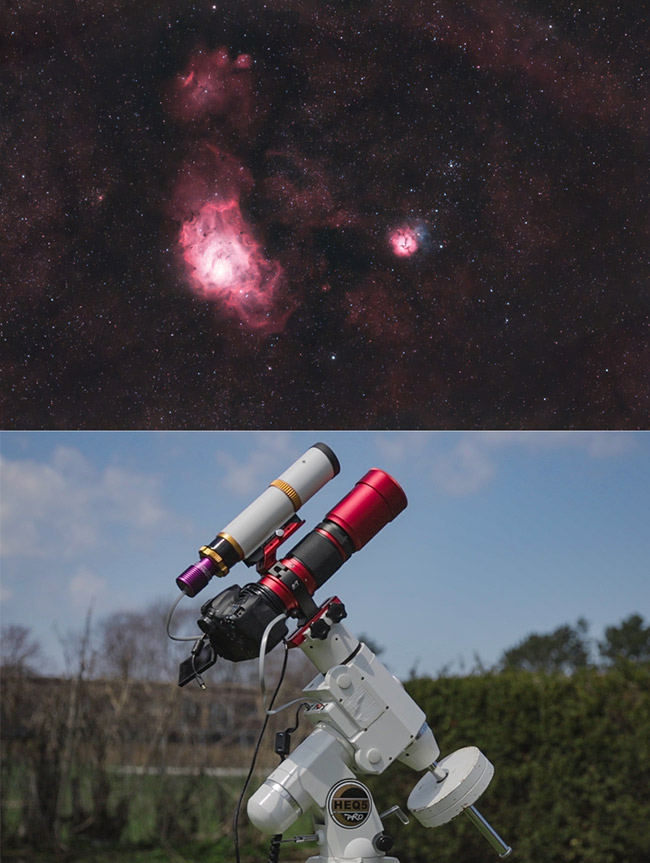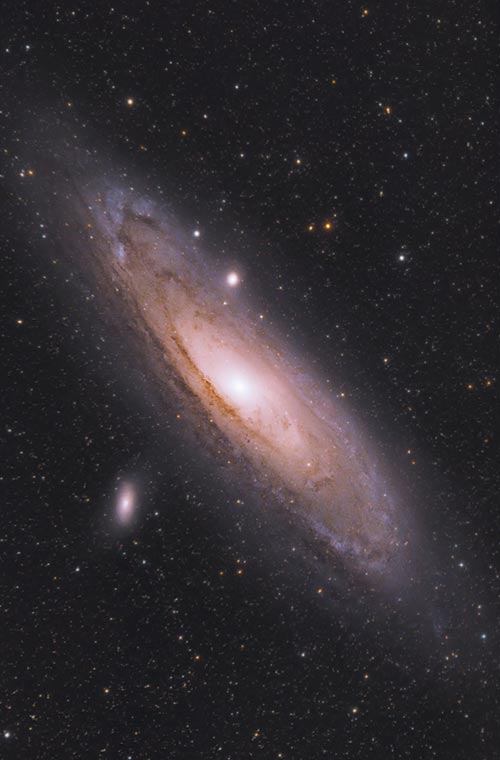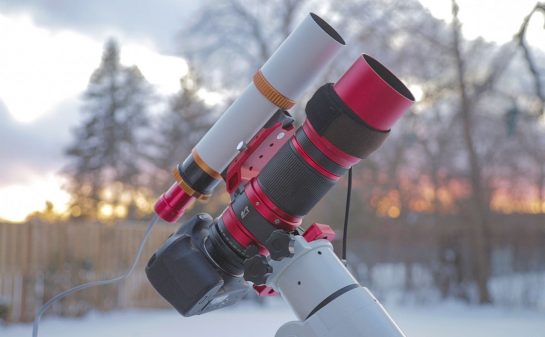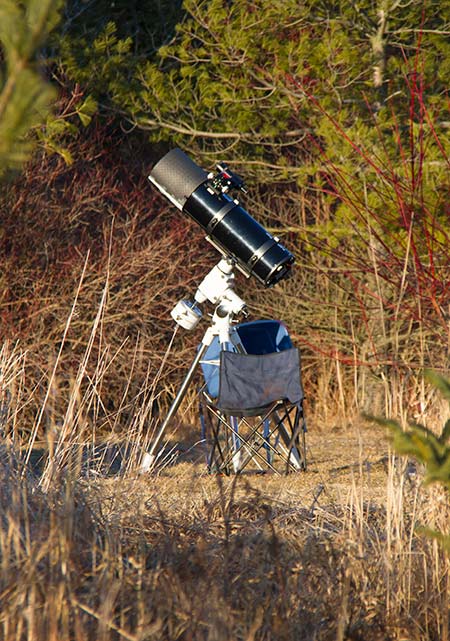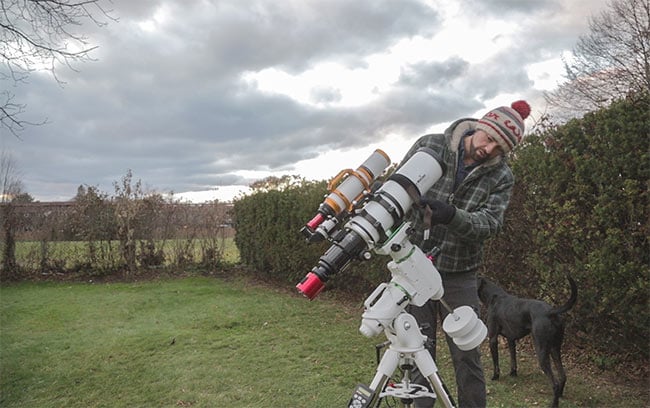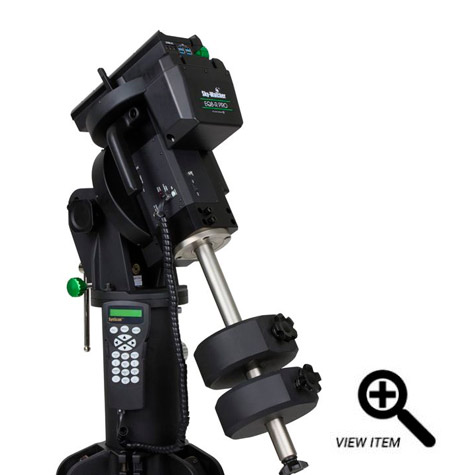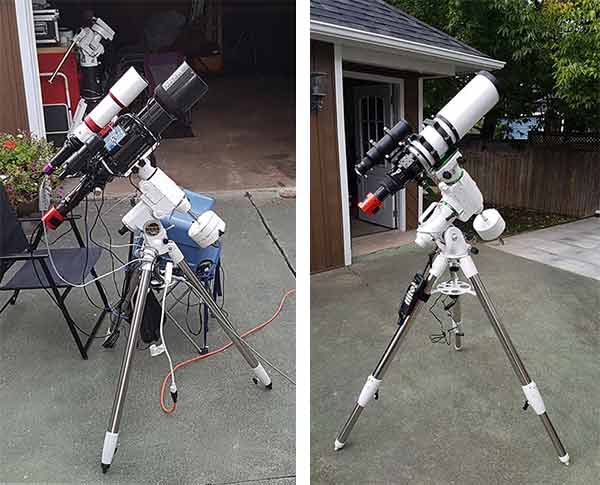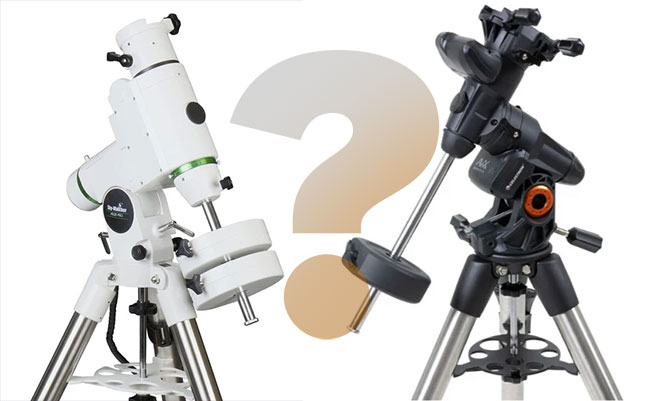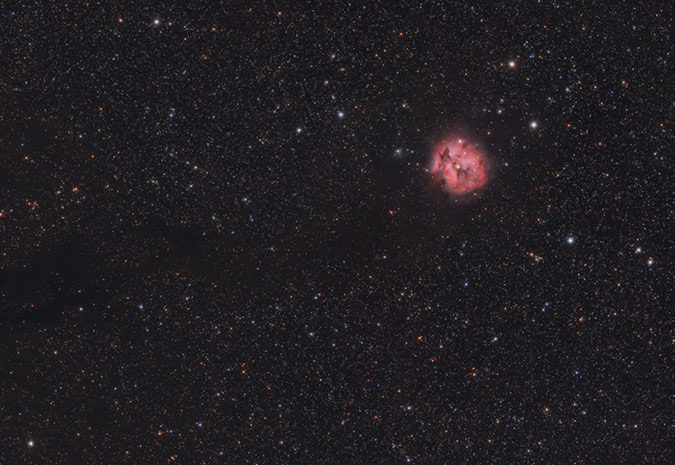Sky-Watcher HEQ5 Review
The Sky-Watcher HEQ5 is a GoTo equatorial telescope mount capable of deep-sky astrophotography. It was one of the first mounts I had ever used for astrophotography, and one I still use to this day.
This telescope mount includes the SynScan system, which offers the user a hand controller to select and track various objects in the night sky. In my experience, the Sky-Watcher HEQ5 provides extremely high precision tracking and works exceptionally well with the use of autoguiding via the built-in autoguider port.
I am often asked by beginner astrophotographers for advice on purchasing their first tracking mount, and the Sky-Watcher HEQ5 is an excellent choice to consider. In this review, I’ll share my insights on this telescope mount, and share many image examples using it.
Sky-Watcher HEQ5 Equatorial Mount Review
The HEQ5 is a big step up from the star tracker category. Some of the major advantages of a telescope mount in this class are GoTo functionality and increased payload capacity.
You can now enter the world of deep-sky astrophotography through a telescope, as the HEQ5 can handle small to medium-sized refractors with ease. You’ll also have the ability to explore other optical designs such as Newtonian reflectors, Schmidt-Cassegrain telescopes, and more.
If you are interested in astrophotography using a DSLR and telescope, the Sky-Watcher HEQ5 is a suitable GoTo mount for a wide variety of imaging configurations.
Here is a recent image captured using the HEQ5, with a William Optics RedCat 51 refractor, and a DSLR mounted on top:
I used this setup to photograph the Lagoon and Trifid Nebulae from my backyard.
I find the SynScan computer system very easy to use, which makes it an enjoyable telescope mount for visual use and astrophotography.
If you have an older Sky-Watcher SynScan mount, you have the option of updating the hand controller firmware using the resources on the Sky-Watcher website.
The Andromeda Galaxy captured using the Sky-Watcher HEQ5 mount.
The HEQ5 continues to get lots of use in my backyard, even though I upgraded to the larger Sky-Watcher EQ6-R Pro in late 2018. The difference in the overall weight between the two mounts is substantial.
On nights when I am only interested in deep-sky astrophotography with my DSLR camera and 73mm refractor, there is no need to set up the larger EQ6-R. The HEQ5 continues to track the night sky flawlessly and provide me with exciting new images.
Take a look at the Sky-Watcher HEQ5 in action for some deep-sky astrophotography in my backyard (video).
Which Telescopes Can You Mount on the HEQ5?
The HEQ5 is essentially just a slightly smaller version of the Sky-Watcher EQ6-R mount, that is less physically demanding to transport and setup (with a lower maximum payload capacity, of course).
The maximum payload capacity of the Sky-Watcher HEQ5 is 30 lbs. This is more than adequate for numerous deep-sky astrophotography configurations using a telescope.
Most often, I use the HEQ5 with a small doublet refractor telescope (William Optics Zenithstar 73) that weighs 5.5 lbs. I have a small 50mm guide scope and guide camera riding on top of the refractor, adding another 2 lbs.
Add the weight of the imaging camera (usually a Canon EOS 60Da), and the entire imaging ensemble is still under 10 lbs. This is an ideal deep-sky imaging setup for larger deep-sky targets such as nebulae and larger galaxies.
A Sky-Watcher HEQ5 Pro SynScan Computerized Mount with a William Optics Z73 riding on top.
In the world of astrophotography, it is best to keep the total overall of your imaging gear well below the maximum payload capacity of your telescope mount. For example, on the HEQ5, I wouldn’t recommend mounting more than 20-lbs of imaging gear on top.
Although the telescope mount is rated at 30 lbs, deep-astrophotography at long focal lengths requires ultra-precise tracking. That is not to say that successful deep-sky imaging with a configuration of 30 lbs on the HEQ5 isn’t possible, but your balance and polar alignment will have to be rock-solid.
Personally, I recommend using a refractor telescope if you plan on imaging galaxies and nebulae with this mount. Below, you’ll see a William Optics RedCat 51 telescope mounted to the HEQ5 with a DSLR camera attached.
With a small imaging rig like this attached, you’ll only need to use one counterweight, and balancing the load in the RA axis is a breeze. At this focal length, you can expect to capture pin-point stars in unguided images of up to 3-minutes, and much longer with the help of autoguiding.
For a list of refractor telescopes I recommend for astrophotography, please view this helpful resource on the topic.
The RedCat 51 (and variations) are a great match for the HEQ5 mount.
Examples of Telescopes Suitable for the Sky-Watcher HEQ5
Refractors
SCT’s
Newtonian Reflectors:
Telescopes I have mounted to the Sky-Watcher HEQ5 for astrophotography:
- Explore Scientific ED80 Triplet APO Refractor
- Explore Scientific ED102 Triplet APO Refractor
- Orion 8″ F/3.9 Newtonian Astrograph
- William Optics Zenithstar 73 Doublet APO Refractor
- William Optics Redcat 51 APO Refractor
The Sky-Watcher HEQ5 Pro SynScan with an 8″ Newtonian Astrograph mounted to it.
I’ve mentioned how reliable and practical the HEQ5 is, but I’d like to discuss other possible options to consider.
The HEQ5 is a great value for the money and should last you a long time (Mine is nearly 10 years old), but you may want to consider a larger equatorial mount if you plan on mounting heavier telescopes on it down the road.
Sky-Watcher HEQ5 vs. EQ6-R
A discussion that often surfaces is whether to invest in the Sky-Watcher HEQ5 Pro SynScan or the larger EQ6-R Pro. The HEQ5 is more affordable than the EQ6-R by about $USD.
The main reasons for the price break are the single saddle mount, the tripod, the maximum payload capacity, and the spur gear drive train.
Other than that, the HEQ5 and EQ6-R Pro mounts share many of the same characteristics. The counterweights, motor drive, GoTo hand controller, guiding and slew speeds are all identical.
They both include a built-in polar alignment scope, an extremely useful tool.
The larger Sky-Watcher EQ6-R Pro.
The biggest advantage the EQ6-R (or older NEQ6) have over the HEQ5 is the ability to handle larger telescopes and more astrophotography gear.
Another difference in the two mounts is the belt-drive system found in the EQ6-R, which some say can make a big difference in tracking accuracy.
I have not found the need to upgrade my Sky-Watcher HEQ5 with the Rowan Belt Mod which replaces the HEQ5 Pro’s original spur gear drive train with timing belts.
The saddles are also different on the HEQ5 and EQ6-R Pro. The HEQ5 has a V-style saddle mount, while the EQ6-R Pro has a dual V, and D-style saddle.
How Much Weight Can the HEQ5 Handle?
The HEQ5 is a perfect fit with a small refractor, with all of the necessary imaging gear. However, using my larger 8″ Newtonian Astrograph is about as heavy as I would recommend for this mount.
Owners of larger refractors or heavier reflector telescopes will benefit from the robust Sky-Watcher EQ6-R Pro or even larger Sky-Watcher EQ8-R Pro.
The Sky-Watcher EQ8-R Pro is their largest telescope mount for extra heavy payloads.
With the added payload capacity comes a higher price tag. If you are on a tight budget, it is worth comparing these models to see which mount is the right fit for your imaging gear. Don’t forget to account for the weight of your primary imaging camera, guide scope, and all other accessories.
In October 2018, I upgraded to the latest version of Sky-Watcher’s EQ6 equatorial mount, the EQ6-R Pro.
Have a look at my results using this mount early on, including autoguiding accuracy here: Sky-Watcher EQ6-R – First Impressions (Video).
The Sky-Watcher HEQ5 and EQ6-R Pro Mounts setup for astrophotography.
Key Features
The Sky-Watcher mounts were designed to be used by amateur astrophotographers and experts alike. Both the HEQ5 and EQ6-R provide extremely high-precision tracking and have built-in autoguider ports.
The astrophotography capabilities of these mounts are impressive, as seen by the countless images found online using extremely popular mounts.
The SynScan system provides a user-friendly menu that allows automatic slewing to over 42,000 objects.
The SynScan system is reliable and easy to use.
The SynScan hand controller also has the ability to connect to your laptop computer with a RS-232 cable. This way, you can control the mount using software from your computer, including a planetarium.
I am currently looking into controlling my Sky-Watcher HEQ5 using EQMOD during my astrophotography sessions in the backyard.
EQMOD is a very popular way of controlling the Sky-Watcher HEQ5, NEQ6, and other mounts directly from a PC. It allows users to use a planetarium and sky chart applications such as Cartes du Ciel to control and align the telescope mount.
Learn more about EQMOD.
Weight and Portability
With the added stability of the EQ6-R comes an added overall weight. If the portability of your telescope equipment is a big concern, the more lightweight HEQ5 version may be a better option for you. The difference in overall weight between the two mounts is about 10 kg (22 lbs), including both counterweights.
At my age, I am able to lift the entire HEQ5 mount, with 1 counterweight (and the telescope) attached quite easily.
Sky-Watcher HEQ5 Pro vs Celestron AVX
A mount that is surely going to get compared to the Sky-Watcher HEQ5 is the Celestron AVX (Celestron Advanced VX). This GoTo telescope mount sits at the same price point as the Sky-Watcher HEQ5, but is much newer.
The AVX is the replacement for the old Advanced Series CG-5 that I used extensively before purchasing a used HEQ5 Pro.
One difference you may experience between these mounts is the polar axis finder scope. Celestron has an “all-star polar alignment” feature that Sky-Watcher does not use.
I believe that the polar alignment scope is an additional accessory for the AVX because of this. You don’t actually need one to polar align the AVX.
Learning how to properly polar align the HEQ5 Pro using the built-in polar alignment scope took a bit of time, but now it’s a 30-second process. I have not tested the tracking accuracy of the AVX out of the box (without modifications or autoguiding).
I have seen many fantastic deep sky images captured using the AVX, but I know that others have had some issues with tracking performance. I believe many of these issues can be dealt with by properly balancing the imaging payload.
Another difference between the Celestron AVX and the Sky-Watcher HEQ5 is that the Celestron mount uses a plain bushing on the DEC axis, the HEQ5 uses a solid (non-bushing) bearing.
Sky-Watcher HEQ5 Specs
- Counter Weight: 2 x 5.1Kgs
- Accessory Tray: Large wall-to-wall
- Motor Drive: 1.8° stepper motors
- GoTo: SynScan Hand Control
- Tripod Height: 97-121cm
- Tripod Weight: 5.6 kg, 1.75″ steel tripod
- Payload Capacity: 13.7 kg
- Slewing Speed: up to 3.4°/sec (800X)
- Guiding Speed: from 0.25X, 0.50X, 0.75X, or 1X
The Cocoon Nebula in Cygnus captured using the Sky-Watcher HEQ5 mount.
Bottom Line:
The Sky-Watcher HEQ5 is a very capable astrophotography mount with all of the features of the larger NEQ6. A wise investment due to its proven reliability and affordability. The payload capacity of 13.7 kg (30 lbs) may limit your use depending on your current imaging equipment.
The Sky-Watcher HEQ5 has provided me with reliable and consistent results for my deep sky astrophotography endeavors, and I still continue to use this mount today. It is lightweight enough to quickly set up in the yard, and that means that I can use it more often.
I’ll also compare this mount to the features offered by similar GoTo telescope mounts at this price point, including the Celestron AVX. The HEQ5 has been updated in many ways since the original version I purchased in 2014.

